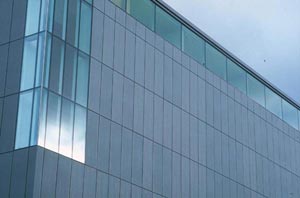

Architectural Rain Screen (ARS) Walls There are several ways to look at Walls, which determine ultimately what kind of product to choose. One thing UBP wall systems have in common is that they are to be considered as Rain Screens or Cold Walls. Rain Screen is basically the opposite of a face sealed wall, as is often found in older Curtain Wall applications. The concept of Rain Screen accepts that water can and will penetrate behind the face of the wall. The correct detailing of a rain screen system deals with minimizing water ingress and by redirecting it to the exterior face of the wall. This means that the air/water barrier needs to be behind the metal. Between the metal and the air/water barrier there is airflow that dries the moisture out. What it comes down to is that in Rain Screen design, the design authority recognizes that water can penetrate the outer skin. In a face sealed application water can get behind the skin but then is not dealt with as the water is not able to get out. Not dealing with moisture in the wall leads to a failing insulation, to mold build up and eventually to overall building envelope degradation and failure. Of course we are aware that leakage on the exterior skin is only one way how water can get into the wall. Condensation is a much more common factor. For this very reason we believe Rain Screen to be the superior system for longevity as well as overall building performance. Once we are clear about Rain Screen there are still two ways to look at a VM ZINC® wall. One way is to look at it basically as a vertical roof but in 90 degrees to the horizon. This is what we call cladding. Typical products for this application are Flat Lock Panels, Standing Seam, Corrugated Panels or Interlocking Panels. This technology can be applied up to building heights of 100’. One thing all these panels have in common is that they are attached to each other and have to go up sequentially. This sort of panel is typically installed by a sheet metal worker. The other Panel family is what we refer to as Architectural Rain Screen (ARS). These are panels that qualify for hi-rise applications or where complex large format shapes are required. The panels are independent from each other and in some systems do not have to be installed sequentially. They are typically installed by the glass and glaziers or other specialty contractors. While cladding panels can be somewhat customized on the job site, ARS panels cannot. They have to be made to fit. There is no last minute cutting and bending possible. Accuracy in take-off, measuring and manufacturing is chief. Traditional sheet metal skills are required only at the flashings. It needs to be understood that there are plenty of overlaps. For instance we could install an IL panel on a hi-rise, if the architect does not mind a through-fastened fixing of the panel and a top-down installation. On the other hand, an ARS panel could be used as fascia on a residential building if the designer so chooses. What remains is that they are two different species of wall panels and it needs to be considered when designing. Regardless which of our systems you use – utilizing a zinc rainscreen addresses two major concerns of modern day architecture an environmentally sound designed built to eliminate the occurrence of mold in the wall cavities. CAD Details and Specification Sheets are available at www.vmzinc-us.com
ECO PANEL The ECO PANEL is designed primarily as an economical cladding for horizontal panel application. The panel system consists of the VM ZINC® panels, an extrusion clip and a drainage channel. The system is of course, back ventilated and pressure equalized. The panel constraints are 2 feet in width and 10 feet in length. Like all other VM ZINC® panels they are available in QUARTZ ZINC® and ANTHRA ZINC®. EURO PANEL The Europanel’s open joint design allows air pressure to equalize between the outside surface and the inside cavity. This reduces the amount of wind-driven rainwater that enters the wall cavity. No sealant or gaskets are incorporated into the system resulting in less dirt accumulation. The panels are supported by continuous tracks at each vertical point. The tracks are designed for water drainage control by stopping penetrating water and leading it to designated exit points. The system is fully weeped, drained and back ventilated to remove condensation from the wall inside the cavity. The panels are hung on intermittent semi-visible or concealed support pins with high impact polycarbonate isolator clips. These clips allow noise-free thermal movement of the VM ZINC® panels in vertical and horizontal directions. Please contact our office or your nearest rep for information on sizes and availability. Like all other VM ZINC® panels they are available in QUARTZ ZINC® and ANTHRA ZINC®. SLIM LINE PANEL Slimline VM ZINC® panels are a simple, easy to install design that meets the requirements for many types of buildings. One of its key features is a very narrow panel depth that allows the architect to integrate the panel into a variety of façade designs. Open joints, and back ventilation make it not only one of the best rain screen systems available, it also is the right answer to avoid mold. Paired with the performance and life span of zinc it is also an environmentally sound decision. Please contact our office or your nearest rep for information on sizes and availability. Like all other VM ZINC® panels they are available in QUARTZ ZINC® and ANTHRA ZINC®. CAD Details and Specification Sheets are available at www.vmzinc-us.com |
